Who doesn’t like upcycling something from trash to treasure? Cardboard boxes are the definition of freebie-to-fantastic enrichment items because they’re available everywhere, incredibly simple and safe to use, and offer great behavioral opportunities for horses. Plus, repurposing and then recycling cardboard is kind to the planet.
Most forage boxes are small because most boxes are pretty small. It’s really easy to find cardboard boxes that are a little bigger than a horse’s face, which is great for putting together a quick and simple forage/novelty/snuffler type of enrichment. But every so often you might run across a gem like this:
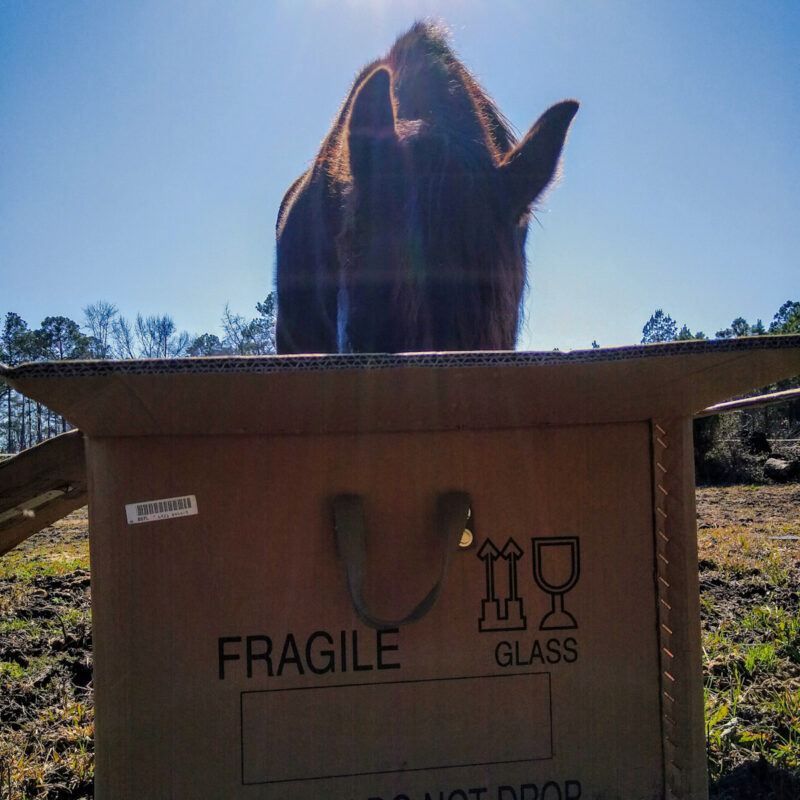
In this post I’ll give you some tips on sourcing big boxes, some safety notes on using them, and plenty of photos of this weekend’s giant box experience. If you want more information on forage boxes in general including what behaviors they’ll best encourage in your horse, check out How to Make a Forage Box for the full scoop.
Is Bigger Better?
Cardboard boxes come in every size and shape from tiny cubes to refrigerator-sized behemoths. A bigger box doesn’t make a better enrichment item for your horse, it creates a slightly different one by encouraging different behaviors:
- Horses focus on smell and touch when working a small box because they can’t easily see inside once their nose is close to the box. With a big box, they can see into the sides and corners, so the horse seeks out treats using vision as well.
- If the box is big enough, it promotes movement as well as feeding and cognition because the horse must walk around the box to search each area for treats.
- Larger cardboard boxes are often double-thickness corrugated cardboard, so they are sturdy enough to stand up to greater use – a horse may “solve” a smaller forage box puzzle by tearing or stomping it apart (which is a cool example of behavior!) but may have to use a different technique to enjoy a big box.
- When offered empty in the pasture so that it may be used for object play, a giant box is more likely to encourage pushing or shoving behavior in addition to using the box as an anchor point for locomotor play. Smaller boxes are more likely to be picked up, carried, and tossed.
Where to Find Them
Big boxes are meant to ship big items, so any facility or store that receives big commodity goods will have them, usually broken down flat and stored in a receptacle.
I was lucky enough to snag this box before it was flattened, making the job easier. And it came with cloth handles – a cool addition that makes it MUCH easier to lug out to the pasture!
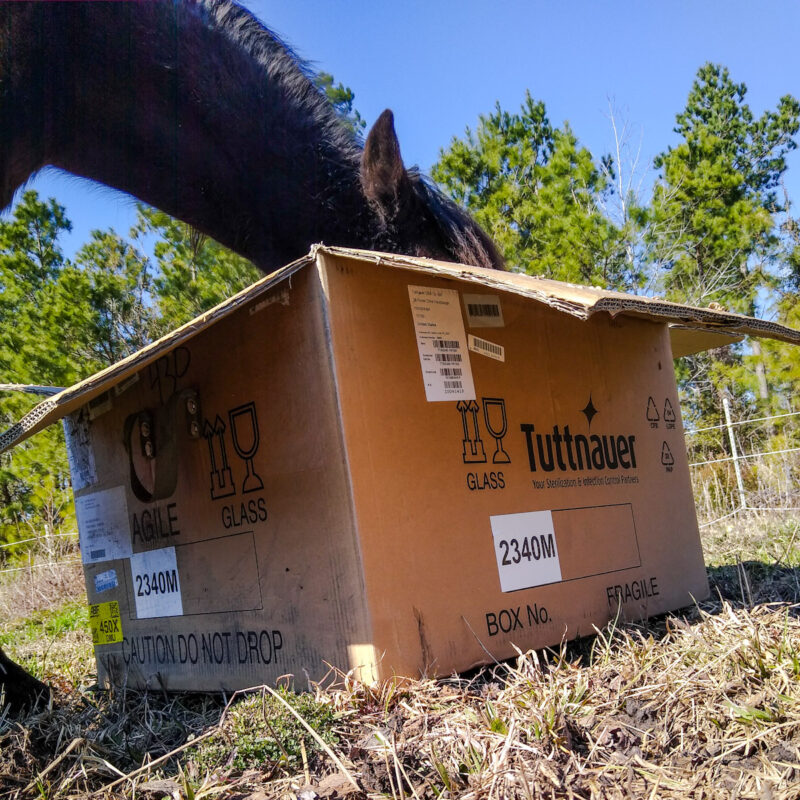
You’ll usually need to speak to someone in person to get access to the cardboard storage area of shops and businesses, but when you do, you might be able to ask the staff to hold onto their next large box without flattening it if you make a plan to retrieve it quickly. Of course, you’ll need a vehicle big enough to transport your find. If you use a pickup truck, be sure to secure the load – cardboard is lightweight and loves to catch the wind. Don’t lose your supersized box halfway down the road home! If you have a smaller car, you can always transport your box flat and then tape it back together when you get to the barn.
These places are good sources of medium to large boxes:
- Grocery stores (medium sized shipping boxes and produce bins)
- Big-box retailers (large shipping boxes)
- Schools and hospitals (medium to large shipping boxes)
- Big-box home improvement and appliance centers (the holy grail: giant boxes for fridges, ovens, etc)
Setup and Safety for Large Boxes
There are a few safety notes to keep in mind when using big boxes as enrichment.
First, commodity-sized boxes are often held together with staples. These MUST be removed because they are a serious eyeball hazard – most of the time they face the interior of the box.

Pull them out with pliers and discard.
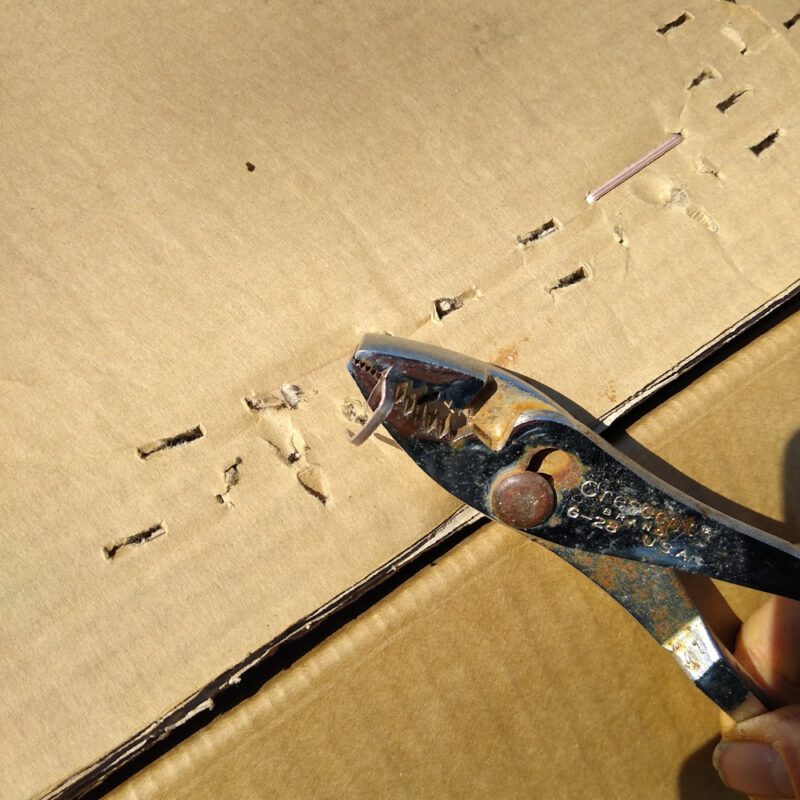
Run your hand carefully all over the inside to find additional staples or brads that may have punched through the first layer of cardboard and can’t be seen from the outside.
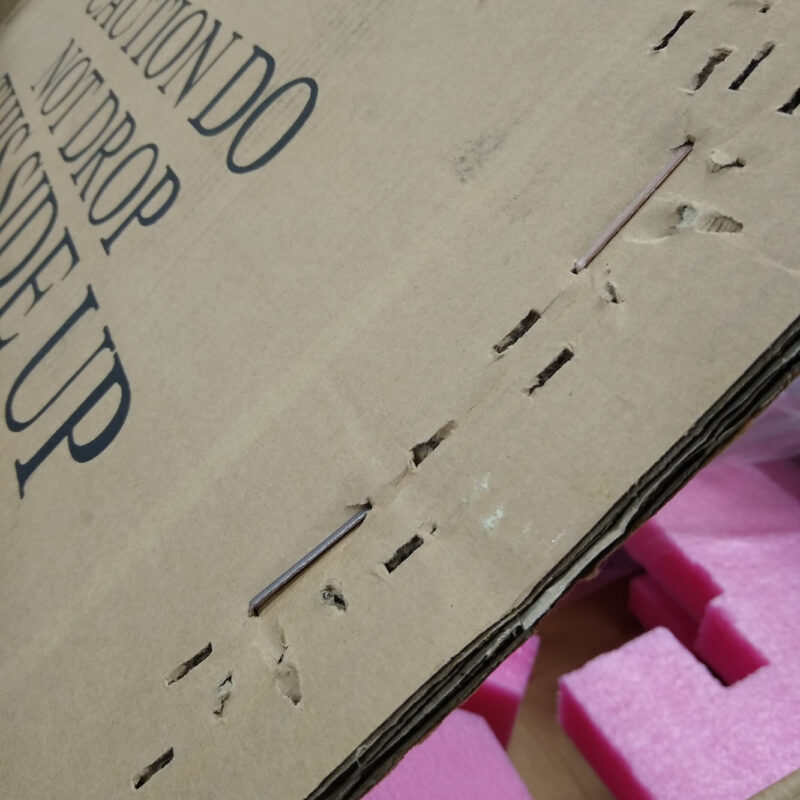
This box came with an interesting set of foam inserts. They created several pockets and nooks that were perfect for hiding treats:
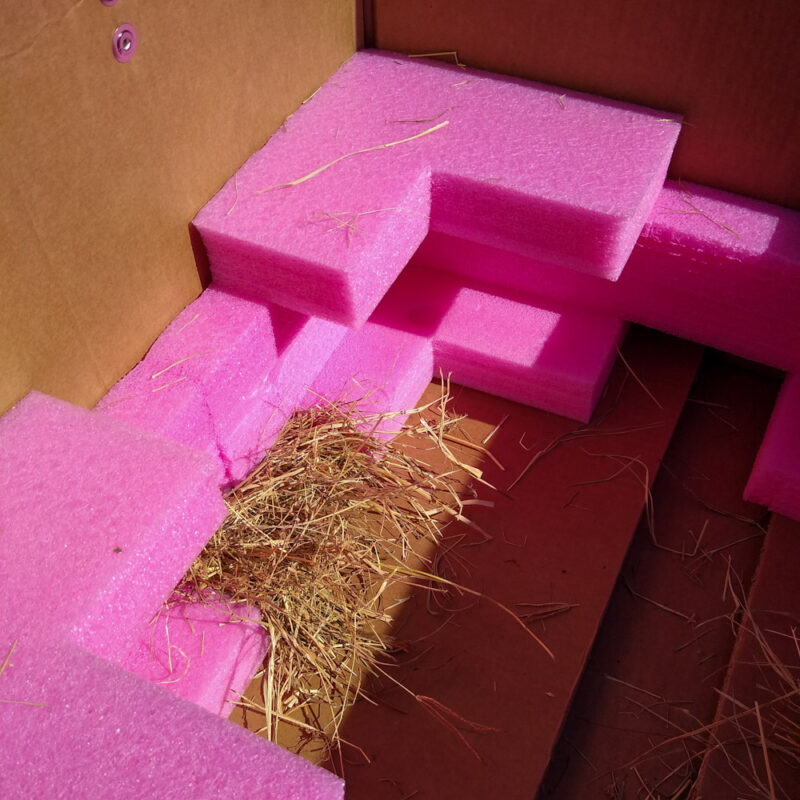
I chose to keep the inserts for the added textural and cognitive value of having to work around the pockets, and it worked well – but only because the foam is the dense, squashy kind that doesn’t come apart into Styrofoam pellets. If your box has white foam inserts, discard them and do NOT use with your box. This type of Styrofoam tends to fray apart into snow-like pellets and loose chunks that will be accidentally or intentionally consumed by the horse. This is an ingestion hazard, so make sure to get rid of that stuff. Same with other loose material like packing peanuts – when in doubt, assume a horse may try to eat them.
Because I wanted to keep the inserts, this enrichment was given supervised-only and removed after the horse finished interacting with it. Without the inserts, the box could be left unsupervised. Remember that whether an enrichment activity can be left unattended with a horse depends on just on the items used, but on the individual.
Check the outside of the box for plastic invoice slips and loose flaps of tape and remove them.
If you’re lucky enough to score a box with handles like this one, don’t leave it with a horse unsupervised. They could catch a hoof, and though the cardboard would probably tear apart quickly, those handles are meant to stay on the box during transport of very heavy objects. At minimum, putting a hoof through a handle or hole in the box could cause a panic before the horse can free itself, which is an injury hazard. If you do want to keep the handles for usability, cut them down the middle – you can still lift the box by the cut section of handle and the horse can’t get caught.
Holes that are just big enough to admit a hoof but not let it back out again can either be taped over or enlarged. The best tool to do this is a serrated steak knife – it gets through multiple layers of cardboard and easily cuts curves in the material, unlike a box cutter.
Testing the Box
For this box, I stuffed hay into any crevices that would otherwise trap treats and make the inaccessible.

Dry treats were placed in the insert nooks…

I added small handful of baby carrots and additional hay to round everything out:
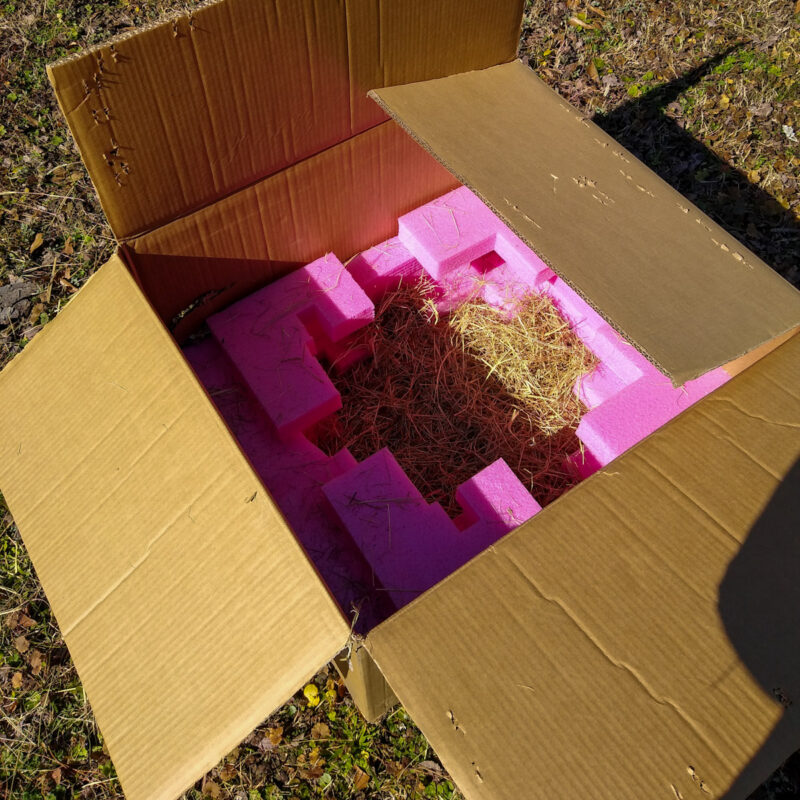
When offering a giant box for the first time, keep it simple and easy. Because the behaviors it encourages are a little different, your horse may need to learn how to use the box effectively, even if they already enjoy smaller boxes.
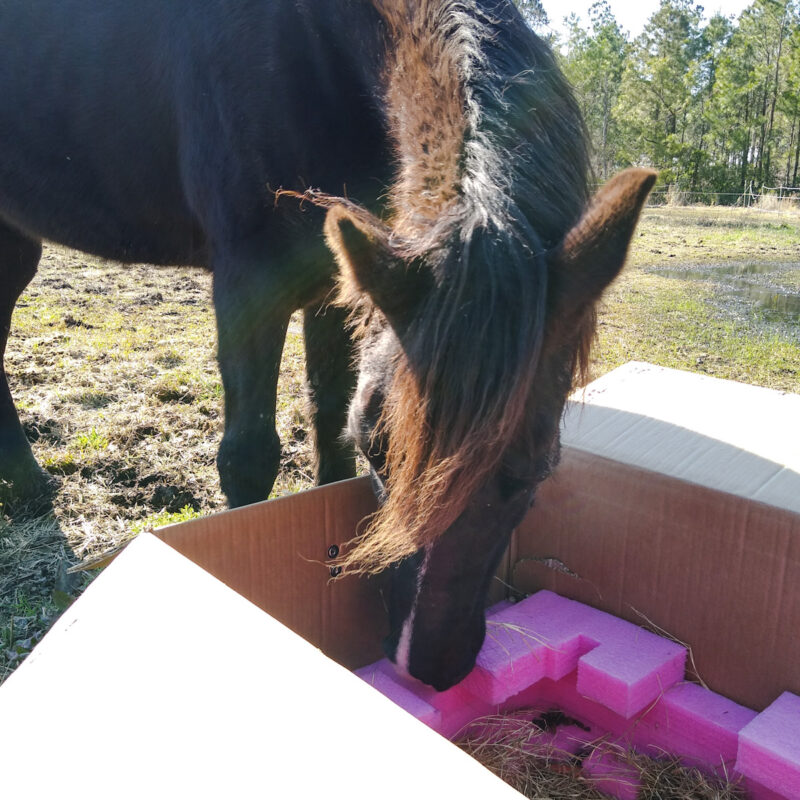
As always, let the horse explore the enrichment at their own pace and expect hesitation and caution the first few times any novel object is used.
I found that this box produced more caution compared to smaller boxes, which were instantly approached and interacted with, but the hesitation evaporated once my horse realized that the strange new cube in the pasture was a scaled-up version of the ever-popular forage box.
Big Box Ideas
A giant forage box can be used in a variety of ways, so you’ll definitely want to keep your big box in a corner of the stable where it can be pulled out and used repeatedly. Here are some ideas to try out:
- Box-in-a-box: place smaller boxes inside the big one to create “cubbies” for placing different forage items – encourages sensory behaviors and response to novelty
- Balls in a box: Place lots of kiddie balls or repurposed plastic bottles in the box with treats underneath – the horse has to shove and nudge the objects aside to get to the forage/treats
- Lasagna: add layers of flat cardboard of different sizes between treats and forage so that the cardboard has to be flipped up and away to reveal the goodies underneath
- Cave: for the biggest boxes, place on their side with the forage at the back to promote exploration and food-seeking
These are just a few of the potential enrichment uses for a giant box. If you score a really big box and have a story to share, drop a comment below!